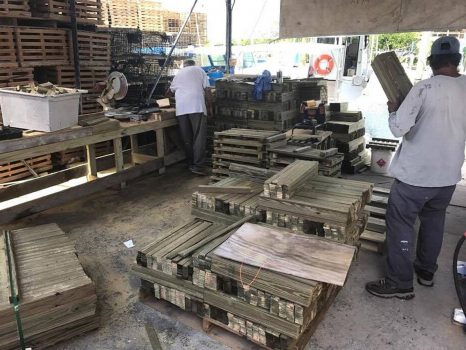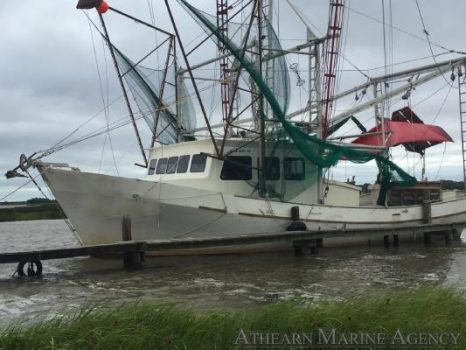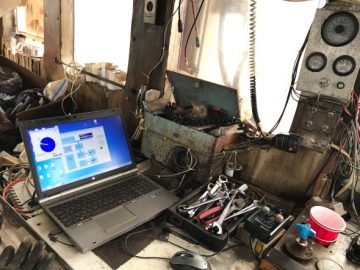Daily Archives: July 5, 2017
Overdose suspected in fisherman’s death – Drug paraphernalia found at scene on boat
Gloucester – The death of a 26-year-old Maine fisherman, found aboard a vessel moored at the Jodrey State Fish Pier over the holiday weekend, is being categorized by the Essex District Attorney’s office as a suspected drug overdose. Neither the state medical examiner’s office nor law enforcement authorities would confirm the identity of the man who was found aboard the FV/Titan at the fish pier off Parker Street early Saturday morning. A positive identification and definitive cause of death were, as of Wednesday, pending findings by state medical examiner’s office, said Carrie Kimball Monahan, spokeswoman for the office of Essex District Attorney Jonathan Blodgett.,,, John McCarthy, Gloucester’s interim police chief, said Wednesday that police and the Fire Department’s rescue squad had responded to a call from an “unknown party” around 5:30 a.m. Saturday reporting an apparent drug overdose on the fishing boat Titan. click here to read the story 19:53
Opposition to Atlantic Siesmic Blasting – The Bipartisan Fight for Quieter Oceans
 Last night, to celebrate the fourth of July, the air over the U.S. filled with fireworks. The noise they created was extremely loud and, mercifully, brief. But imagine having to listen to even louder explosions once every ten seconds, for days or weeks on end. Starting this fall, that may be the new reality for whales, fish, and other marine life off the eastern seaboard, if the Trump administration’s plans go ahead. Following the president’s executive order to open the Atlantic to offshore drilling, the National Marine Fisheries Service (NMFS) is set to permit five companies to begin seismic airgun blasting—an old but controversial technique for detecting reserves of oil and gas.,,, It is easy to paint environmental issues as fights between moralizing tree-huggers and hard-working business-owners. But the opposition to airgun testing transcends such caricatures. “There is no separation between the interests of environmentalists and the business community,” says Knapp, whose bipartisan organization represents 41,000 businesses and 500,000 commercial fishing families who oppose seismic testing. click here to read the story 17:34
Last night, to celebrate the fourth of July, the air over the U.S. filled with fireworks. The noise they created was extremely loud and, mercifully, brief. But imagine having to listen to even louder explosions once every ten seconds, for days or weeks on end. Starting this fall, that may be the new reality for whales, fish, and other marine life off the eastern seaboard, if the Trump administration’s plans go ahead. Following the president’s executive order to open the Atlantic to offshore drilling, the National Marine Fisheries Service (NMFS) is set to permit five companies to begin seismic airgun blasting—an old but controversial technique for detecting reserves of oil and gas.,,, It is easy to paint environmental issues as fights between moralizing tree-huggers and hard-working business-owners. But the opposition to airgun testing transcends such caricatures. “There is no separation between the interests of environmentalists and the business community,” says Knapp, whose bipartisan organization represents 41,000 businesses and 500,000 commercial fishing families who oppose seismic testing. click here to read the story 17:34

California Dungeness crab industry bounces back with strong season
Crabbers, seafood processors and state biologists agree that the most recent Dungeness crab season, which ended June 30 south of Mendocino County, was above average. Considering the disastrous previous season of 2015-16, which featured historic, months-long closures in the Dungeness crab fishery due to the presence of domoic acid in the animals, that’s more than above-average news. “We made some money,” said Shane Lucas, who fishes for crab out of Bodega Bay, where he also owns the Fishetarian Fish Market. Based on preliminary data, the 2016-17 season brought in over 21 million pounds of Dungeness crab to California ports, worth $66.7 million.,,, But this year’s crab season was not without its issues. click here to read the story 16:33

One Month Later: Clearing, rebuilding start at Vaca Key Marina following devastating fire
It has been one month today since an early-morning fire tore through the bayside Vaca Key Marina near mile marker 47.5. In the four weeks since thousands of lobster traps, a house, boats and forklifts were destroyed on the one-acre property owned by the Berdeal family of Miami on June 5, fishermen at the marina have been busy rebuilding. Clearing of the many piles of charred wood and concrete began Monday at the marina, said Juan Carlos Berdeal. Marathon business Discount Rock and Sand did the clearing with front-end loaders and dump trucks. click here to read the story 13:14

Athearn Marine Agency Boat of the Week: 58′ Fiberglass Shrimper, Twin 3406B Cat’s, Izusu 8 KW Genset
Specifications, information and 7 photos click here To see all the boats in this series, Click here 11:51
UPDATE: Two of four partially submerged fishing vessels recovered
 The U.S. Coast Guard said Tuesday that two of four partially submerged fishing vessels had been recovered. Petty Officer Bill Colclough of the U.S. Coast Guard said multiple agencies were working to retrieve the other two remaining vessels. “We’re working with the vessel owners to safely recover those vessels from the waterway,” Colclough said. Colclough said there were harsh conditions in the Nushagak Bay area on Monday. “In Nushagak Bay and near Dillingham, there are a series of sand bars and harsh there were harsh weather conditions present yesterday combined with the shifting sand bars that made it much more difficult,” Colclough said. click here to read the story 11:25
The U.S. Coast Guard said Tuesday that two of four partially submerged fishing vessels had been recovered. Petty Officer Bill Colclough of the U.S. Coast Guard said multiple agencies were working to retrieve the other two remaining vessels. “We’re working with the vessel owners to safely recover those vessels from the waterway,” Colclough said. Colclough said there were harsh conditions in the Nushagak Bay area on Monday. “In Nushagak Bay and near Dillingham, there are a series of sand bars and harsh there were harsh weather conditions present yesterday combined with the shifting sand bars that made it much more difficult,” Colclough said. click here to read the story 11:25
How lobstermen gather temperature data from the bottom of the ocean
 A few decades ago, Jim Manning wanted to know what was at the bottom of the sea. And after years of studying waterways on the Atlantic coast, he says he’s seen a steady change in ocean temperatures that he calls ‘unprecedented.’ Manning is an oceanographer at NOAA’s Northeast Fisheries Science Center (NEFSC) in Woods Hole, Massachusetts. He partners with lobstermen on the Northeast Shelf from Maine to New York, attaching low-cost temperature and depth loggers to some of the millions of lobster traps deployed throughout New England. The project, called eMOLT (Environmental Monitors on Lobster Traps) records and plots . click here to read the story 09:31
A few decades ago, Jim Manning wanted to know what was at the bottom of the sea. And after years of studying waterways on the Atlantic coast, he says he’s seen a steady change in ocean temperatures that he calls ‘unprecedented.’ Manning is an oceanographer at NOAA’s Northeast Fisheries Science Center (NEFSC) in Woods Hole, Massachusetts. He partners with lobstermen on the Northeast Shelf from Maine to New York, attaching low-cost temperature and depth loggers to some of the millions of lobster traps deployed throughout New England. The project, called eMOLT (Environmental Monitors on Lobster Traps) records and plots . click here to read the story 09:31
Robots used to cut crab may actually help keep processing jobs in Newfoundland and Labrador
 The world’s first full-on crab plant robot sits inside a tall, plastic chamber roughly the size of a shipping container. A conveyer belt carries the splayed crab into the chamber, where a robotic scoops them up and places them on one of two plastic saddles. And then the blade descends. The legs tumble into a grey plastic tub below, sorted, sectioned and ready to go. The machine was unveiled this spring, developed by Canadian Centre for Fisheries Innovation, in partnership with Ocean Choice International and the Marine Institute. Its functions are simple — cut the crab in half, or remove its legs — but its impact could be enormous. Its designers are also hoping it will solve a few workforce problems in fish plants caused by changing demographics in rural Newfoundland. click here to read the story 08:52
The world’s first full-on crab plant robot sits inside a tall, plastic chamber roughly the size of a shipping container. A conveyer belt carries the splayed crab into the chamber, where a robotic scoops them up and places them on one of two plastic saddles. And then the blade descends. The legs tumble into a grey plastic tub below, sorted, sectioned and ready to go. The machine was unveiled this spring, developed by Canadian Centre for Fisheries Innovation, in partnership with Ocean Choice International and the Marine Institute. Its functions are simple — cut the crab in half, or remove its legs — but its impact could be enormous. Its designers are also hoping it will solve a few workforce problems in fish plants caused by changing demographics in rural Newfoundland. click here to read the story 08:52













































